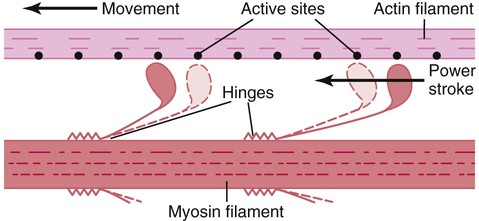• Describe concentric, eccentric, and isometric activation of muscle. • Identify the anatomic components that constitute a whole muscle. • Describe the sliding filament theory. • Describe how cross-sectional area, line of pull, and shape help determine the functional potential of a muscle. • Describe the active length-tension relationship of muscle. • Describe the passive length-tension relationship of muscle. • Explain why the force production of a multi-articular muscle is particularly affected by its operational length. • Describe the principles of stretching muscular tissue. • Describe the basic principles of strengthening muscular tissue. A fundamental principle of kinesiology states that when a muscle contracts, the freest (or least constrained) segment moves. This principle applies whether a muscle is pulling its distal attachment toward its proximal attachment or vice versa (Figure 3-1). An active muscle develops a force in only one of the following three ways: These muscle activations are referred to as concentric, eccentric, and isometric, respectively. Concentric activation occurs as a muscle produces an active force and simultaneously shortens; as a result, the muscle decreases the distance between its proximal and distal attachments. During a concentric contraction, the internal torque produced by the muscle is greater than the external torque produced by an outside force (Figure 3-2, A). Eccentric activation occurs as a muscle produces an active force—attempts to contract—but is simultaneously pulled to a longer length by a more dominant external force. During eccentric muscular activation, the external torque, often generated by gravity, exceeds the internal torque produced by muscle. Most often, gravity or a held weight is allowed to “win,” effectively lengthening the muscle in a controlled manner. For example, slowly lowering a barbell involves eccentric activation of the elbow flexors. As a consequence, the proximal and distal attachments of the muscle become farther apart (Figure 3-2, B). Muscles that work together to perform a particular action are known as synergists; furthermore, most meaningful movements of the body involve the synergistic action of muscles. A force-couple is a type of synergistic action that occurs when two or more muscles produce force in different linear directions but produce torque in the same rotary direction. Figure 3-3 illustrates the force-couple generated by three different shoulder muscles to upwardly rotate the scapula. Figure 3-4 illustrates the primary functional components that constitute skeletal muscle, whereas Box 3-1 describes each of these components. A whole muscle consists of three main components, each surrounded by a particular type of connective tissue that supports its function. Figure 3-5 illustrates a sarcomere and emphasizes the physical orientation of the actin and myosin filaments. The thick myosin filament contains numerous heads, which when attached to the thinner actin filaments create actin-myosin cross bridges. In essence, a myosin head is similar to a cocked spring, which on binding with an actin filament flexes and produces a power stroke. The power stroke slides the actin filament past the myosin, resulting in force generation and shortening of an individual sarcomere (Figure 3-6). Because sarcomeres are joined end to end throughout an entire muscle fiber, their simultaneous contraction shortens the entire muscle.
Structure and Function of Skeletal Muscle
Fundamental Nature of Muscle

Types of Muscular Activation
Concentric
Eccentric
Muscle Terminology

Muscular Anatomy

The Sarcomere: The Basic Contractile Unit of Muscle


Structure and Function of Skeletal Muscle









